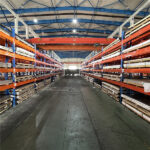Duplex 2205 Stainless Steel Metal Plate S32305 Stainless Steel Sheet
Product Description
Alloy 2205 (UNS S32305/S31803) is a 22% chromium, 3% molybdenum, 5-6% nickel, nitrogen alloyed duplex stainless steel plate with high general, localized, and stress corrosion resistance properties in addition to high strength and excellent impact toughness.
Chemical Composition (%)
| Grade | C | Mn | Si | P | S | Cr | Mo | Ni | N |
| 2205 | ≤0.03 | ≤2.00 | ≤1.00 | ≤0.04 | ≤0.03 | 21.0-24.0 | 2.5-3.5 | 4.5-6.5 | 0.08-0.2 |
Mechanical Properties at Room Temperature
| ASTM A 240 | Typical | |
| Yield Strength 0.2%, ksi | 65 min. | 74 |
| Tensile Strength, ksi | 90 min. | 105 |
| Elongation, % | 25 min. | 30 |
| Hardness RC | 32 max. | 19 |
Tensile Properties at Elevated Temperatures
| Temperature °F | 122 | 212 | 392 | 572 |
| Yield Strength 0.2%, ksi | 60 | 52 | 45 | 41 |
| Tensile Strength, ksi | 96 | 90 | 83 | 81 |
Processing Method
Forming below 600°F is recommended whenever possible. When hot forming is required, the workpiece should be heated uniformly and worked in the range of 1750 to 2250°F. Alloy 2205 duplex stainless steel plate is quite soft at these temperatures and is readily formed. Above this range, 2205 is subject to hot tearing. Immediately below this range, the austenite becomes substantially stronger than the ferrite and may cause cracking, a particular danger to “cold” edges. Below 1700°F there can be rapid formation of intermetallic phases because of the combination of temperature and deformation. Whenever hot forming is done, it should be followed by a full solution anneal at 1900°F minimum and rapid quench to restore phase balance, toughness, and corrosion resistance. Stress relieving is not required or recommended; however, if it must be performed, the material should receive a full solution anneal at 1900°F minimum, followed by rapid cooling or water quenching.
Alloy 2205 duplex stainless steel plate is readily sheared and cold formed on equipment suited to working stainless steels. However, because of the high strength and rapid work hardening of 2205 duplex stainless steel plate, forces substantially higher than those for austenitic steels are required to cold form it. Also because of the high strength, a somewhat larger allowance must be made for springback.
Alloy 2205 duplex stainless steel plate should be annealed at 1900°F minimum, followed by rapid cooling, ideally by water quenching. This treatment applies to both solution annealing and stress relieving. Stress relief treatments at any lower temperature carry the risk of precipitation of detrimental intermetallic or nonmetallic phases.
Alloy 2205 duplex stainless steel plate should be annealed at 1900°F minimum, followed by rapid cooling, ideally by water quenching. This treatment applies to both solution annealing and stress relieving. Stress relief treatments at any lower temperature carry the risk of precipitation of detrimental intermetallic or nonmetallic phases.
Alloy 2205 duplex stainless steel plate possesses good weldability. The goal of welding 2205 is that the weld metal and heat-affected zone (HAZ) retain the corrosion resistance, strength, and toughness of the base metal. The welding of 2205 is not difficult, but it is necessary to design welding procedures that lead to a favorable phase balance after welding and will avoid precipitation of detrimental intermetallic or nonmetallic phases.
Alloy 2205 duplex stainless steel plate can be welded by: GTAW (TIG); GMAW (MIG); SMAW ("stick" electrode); SAW; FCW; and PAW.











.jpg)
.jpg)
.jpg)




